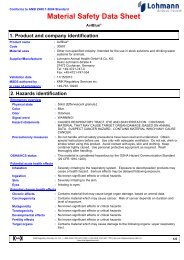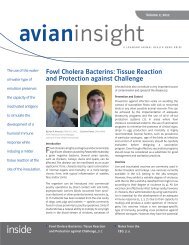Farm Vaccination - Injection Method Oil Emulsion Vaccines
Farm Vaccination - Injection Method Oil Emulsion Vaccines
Farm Vaccination - Injection Method Oil Emulsion Vaccines
You also want an ePaper? Increase the reach of your titles
YUMPU automatically turns print PDFs into web optimized ePapers that Google loves.
<strong>Farm</strong> <strong>Vaccination</strong> - <strong>Injection</strong> <strong>Method</strong> <strong>Oil</strong> <strong>Emulsion</strong> <strong>Vaccines</strong><br />
Eric James Lovell, DVM, MAM, ACPV<br />
Introduction<br />
<strong>Oil</strong> emulsion vaccines have played a major role in the poultry industry. Vaccinating with oil emulsions produces a<br />
high level of immunity that is long lived. The use in breeders allows progeny protection, through maternal antibodies<br />
(MAB), which begins at one day of age.<br />
<strong>Emulsion</strong>s are stable mixtures of two immiscible liquids. <strong>Emulsion</strong>s are not unique to vaccines. Milk, rubber latex,<br />
mayonnaise, ice cream, lotions, polishes and insecticides are all examples of emulsions. <strong>Oil</strong> emulsion vaccines are<br />
composed of oil, water (containing the antigen) and surfactants. The aqueous phase (the water containing the<br />
antigen) is dispersed into microscopic globules. This is the internal or discontinuous phase. The oil surrounds the<br />
aqueous phase and is called the continuous or external phase. Most oil emulsion vaccines use mineral oil, a nonmetabolizable<br />
oil. Surfactants are added to both the oil and aqueous phase to help emulsify the two liquids and<br />
provide stability.<br />
The mineral oil serves two purposes. One is to stimulate the immune system to produce an enhanced immune response.<br />
The other is to allow a slow release of antigen to stimulate the immune system over a long period. Killed<br />
vaccines using lecithin oil (a metabolizable oil) or AlOH (water base vaccine), rather than mineral oil, produce less<br />
immune stimulation for a shorter duration. With a single injection of an oil emulsion vaccine, emulsion can still be<br />
detected histologically twenty-eight weeks post-vaccination. Giving two injections before production can provide<br />
protection throughout the production cycle in breeders and provide high levels of maternal antibodies to progeny.<br />
However, antibody titers will gradually decrease and the %CV will increase during the life of a flock. To help maintain<br />
uniformity in a flock and the highest level of MAB in the progeny, many producers give a mid-lay injection.<br />
Storage and Handling<br />
<strong>Oil</strong> emulsion vaccines should be stored between 35º - 45º F (2º - 7º C). Heating and freezing must be avoided. Failure<br />
to properly store oil emulsion vaccines can lead to product failure due to a broken emulsion. An oil emulsion vaccine<br />
can have four distinct appearances: a) normal, b) creaming, c) antigen settling, and d) broken emulsion. A normal<br />
oil emulsion should appear as a homogeneous white to slight off-white liquid. The off-white appearance is usually<br />
noticed when the antigenic content is high, as with multiple antigen vaccines, or when tissue culture antigen is<br />
used. This off-white appearance is normal for those products. Creaming occurs due to excess, free oil floating on<br />
the top of the emulsion. A vaccine that has creamed will have two layers, a light white or clear top layer above the<br />
normal white colored oil emulsion. This is a normal process that occurs sporadically during shipment. If the vaccine<br />
is gently shaken, the normal appearance will return and creaming will probably not occur again during storage.<br />
Settling usually occurs with vaccines of high antigenic content. The small globules of water (antigen) surrounded<br />
by oil are heavier than the oil alone; therefore, they settle toward the bottom. The vaccine will be white from top<br />
to bottom with a gradual increase in darkness toward the bottom. This is not a broken emulsion. This product can<br />
be gently shaken and used. A broken emulsion occurs when the aqueous and oil phases of a vaccine separate from<br />
each other. The vaccine will have two, well-defined layers. There will be the normal emulsion, white color, with a tea<br />
to coffee colored water layer at the bottom. If a broken emulsion is shaken, it will appear normal but within a few<br />
hours the two phases will separate again. When an emulsion breaks the vaccine should not be used. If injected, the<br />
broken emulsion will initially produce a high immune response, but the response will be short-lived.<br />
Before use, oil emulsion vaccines should be removed from refrigeration the night before use and slowly warmed to<br />
room temperature (25º C). Do not apply heat to warm the vaccine or place in direct sun light. Prior to use, oil emulsion<br />
vaccines should be gently shaken. Remove the metal cover and clean the rubber stopper with alcohol. Use a<br />
clean, sterile injection set up. Insert the needle through the rubber stopper and prime the injector. Each bird must<br />
be vaccinated with a full dose of vaccine.<br />
Prevention first.
<strong>Method</strong> of Application<br />
To achieve the maximum potential from killed vaccines, each bird must be properly injected with a full dose of<br />
vaccine. Vaccine can be injected intramuscularly (IM) in the breast, wing, leg or tail head or subcutaneously (SQ) in<br />
the neck. When injecting SQ , use an 18-gauge, 1/2 inch needle. An 18-gauge, 1/4 inch needle should be used when<br />
injecting IM.<br />
Neck - The skin on the back of the neck should be lifted up to create a pocket between the skin and neck muscles.<br />
Insert the needle through the skin into this pocket with the needle pointing toward the bird’s body. The site of injection<br />
should be the middle to lower neck region on the dorsal mid-line of the neck. There will be resistance as the<br />
needle passes through the skin followed by free movement into the SQ space. If this difference is not noticed or is<br />
followed by resistance again, the needle may be in the skin, the neck muscle or the spinal cord. Avoid injecting vaccine<br />
into the neck muscles, intradermally or too close to the head.<br />
Breast - Vaccine is injected into the superficial pectoral muscle about 1 to 1.5 inches lateral to the keel bone, depending<br />
on the age of the bird. The needle should be directed caudally at a 45º angle to the body. This will help avoid<br />
injecting the vaccine through the muscle and into the body cavity.<br />
Leg - When using the leg muscle for vaccination, the injection should be made in the lateral side of the gastrocnemius<br />
muscle mid-way between the stifle joint and the body. The needle is directed proximally. Avoid major vessels,<br />
nerves, joints and the bone.<br />
Wing - The wing muscle (medial side of the biceps) can be used as an alternative IM site. The injection is made into<br />
the large muscle group on the under side of the wing. The needle is pointed toward the body. Avoid major vessels<br />
and the bone.<br />
Tail Head - This injection is made into the underside of the tail head. The needle is directed to the side of the tail<br />
bone and pointed cranially. Care should be taken to not withdraw the needle too quickly. A fast withdrawal can lead<br />
to leakage of vaccine out of the injection site.<br />
There is always the concern that one injection site may produce superior immunity to another. Research has shown<br />
that all common injection sites can give satisfactory results if done properly. Mutalib et. al. found only minor differences<br />
in antibody titers in birds vaccinated in the thigh, breast, wing and neck a with Newcastle (ND) vaccine and<br />
no difference in titers with Infectious Bronchitis vaccine. Glisson et. al. vaccinated birds with Pasteurella multocida<br />
bacterin in the tail, wing, leg, breast and the neck. There was no significant difference in ELISA titers or in protection<br />
when challenged. When selecting the injection site, consideration should be given to ease of application, reaction at<br />
the injection site and human safety. Comparisons to decide which injection site gives the best result in an individual<br />
operation may be helpful.<br />
Monitoring<br />
<strong>Vaccination</strong> should be monitored to ensure the full potential of the vaccine is achieved. Serology is useful in evaluating<br />
the birds’ response to vaccination. ELISA is the most widely used test. Virus neutralization (VN) is another<br />
valuable test. VN shows the level of neutralizing, or protective, antibodies. Hemagglutination inhibition (HI) can be<br />
used for ND, paramyxovirus - type 3 and avian influenza. The antibody level and uniformity of the flock’s immune<br />
response will help give some indication of the vaccination crew’s technique.<br />
Evaluation should also include visits to the field to work with the vaccination crew. <strong>Vaccination</strong> crews should be<br />
educated in proper technique and vaccine handling. To evaluate the crew’s vaccination technique, the injection site<br />
should be examined shortly after vaccination. With the SQ neck injection, the feathers at the injection site can be<br />
separated to allow visualization of the vaccine under the skin. To see vaccine through the skin, examination should<br />
be done within an hour of vaccination. As the time between vaccination and examining birds increases, the vaccine<br />
will disperse into the SQ tissue and be difficult to see. The feathers around the injection site should be dry. Wet<br />
feathers may be the result of early retraction of the needle, vaccination through both layers of skin or vaccine leakage<br />
out of the injection site. Vaccine will leak back if a large bore needle is used, the needle has a spur or the vaccine<br />
is not injected deep enough into the tissue.<br />
Prevention first.
Other potential vaccine injection errors may include the following. Intradermal injections may occur during the<br />
SQ neck injection. If vaccine is injected intradermally, the vaccine will cause the skin to bulge, like a blister, at the<br />
injection site. The bird’s body will respond by walling off the vaccine. With time, the skin will rupture releasing the<br />
vaccine. When vaccine is injected into the neck muscle rather than the SQ space, birds will be slightly depressed<br />
post-vaccination. As the area heals and scar tissue forms, the bird’s neck may become permanently twisted. If the<br />
needle passes through the neck muscle, vaccine can be injected into the spinal cord. Birds will usually die within an<br />
hour if vaccinated into the spinal cord. Vaccinating too close to the head can result in swollen heads since there is<br />
little SQ space for inflammation as the immune system responds to the vaccine.<br />
<strong>Vaccination</strong> with the other methods can also cause problems if not performed correctly. Improper injection into<br />
the leg can cause sore legs and joints. If the needle is inserted into the medial side of the leg, there is a chance of<br />
damaging vessels and nerves. <strong>Vaccination</strong> through the breast muscle into the body cavity can occur during the IM<br />
breast injection. This is usually the result of inserting the needle perpendicularly into the breast rather than at 45º<br />
angle. The result of injecting vaccine intraperitoneal is the formation of adhesions. When performing the tail head<br />
injection, the spinal cord must be avoided. To further evaluate injection technique, cull birds can be necropsied to<br />
evaluate the injection site with all the methods described. Visits to evaluate the vaccination crew should be unannounced<br />
to assure you are getting a true picture of the vaccination technique.<br />
Prevention first.
















